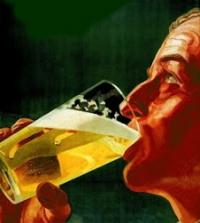I think as long as you keep in mind the volume of water you're modifying, you're fine. If you add them to the MT (or really you could just add them to your strike and sparge water as well) then you are adding enough to raise both your strike and sparge water - so you have to add enough to get to the ppm you need for that amount of water. If adding to the boil, you add enough based on what you're finished volume is - 5 gallons or whatever. If you add to finished beer just realize that the salt will drive off some of the carbonation, so that is also going to change the flavor as well. It may be difficult to determine if the difference in flavor is a result of sulfate/chloride or carbonation differences, but I think it's worth playing around with.This gives me an idea - if you added 5 tablespoons of epsom salt to 5 gallons of ale - you might be able to market it as a detoxification/colon cleaning beer. That seems to be all the rage now a days...Thanks Joe. Yeah, I was actually having a similar conversation about that this morning and the other part of it is that more of the salts will make it into the primary if they're added to the brewpot than they would if they were added to the MT, apparently.

Palmer's chloride-to-sulfate ratio...
#21

Posted 03 March 2010 - 05:56 AM
#22

Posted 03 March 2010 - 07:55 AM
Hey, I like it. We can call it Express Train Pale Ale. It will have all of the best effects of beer, colon cleansers, laxatives and diet supplements! Oh yeah, TV infomercials, here I come!This gives me an idea - if you added 5 tablespoons of epsom salt to 5 gallons of ale - you might be able to market it as a detoxification/colon cleaning beer. That seems to be all the rage now a days...
#23

Posted 04 March 2010 - 11:54 AM
#24

Posted 06 March 2010 - 09:17 AM
#25

Posted 11 March 2010 - 08:23 AM
#26

Posted 11 March 2010 - 08:33 AM
The nice thing about palmer's spreadsheet is that for most of the final values if something is way off in left field it gets highlighted in red. Those numbers look okay to me but I'm no expert.I can't help but think that with these thoughts of mash chemistry, I have somehow turned off the road of "beer-loving guy" and onto the road of pocket protector-wearing geekoid. That said, I continue to look at this topic, even in my sleep (not kidding). So I made my SRM 9 lager on Tuesday and all seemed to go well. I tasted the wort on the way from brewpot to primary and it didn't make me go blind, so that's a plus.Now, a question. My next 2 beers are going to be light in color. Next week, a cream ale with 1056 and the week after that, an American Lager with the WLP840 that is currently working on my amber lager I made earlier in the week. I decided that with my higher bicarbonate number (138) and because these are low SRM beers that I will dilute the mash water 3:1 with distilled. Then, to get my SRM range and ratio set, I am adding 1g of gypsum, 2g of CaCl and 1g of epsom salt to the mash. My sparge water will be all filtered tap water and the sheet has suggested an additional 1.7g of gypsum, 3.3g of CaCl and 1.7g of epsom salt to the boil. The numbers go calcium 92, magnesium 17, sodium 9, chloride 100, sulfate 90, alkalinity 81, RA -33, chloride-to-sulfate ratio "balanced" and an ideal SRM range of 2 to 7. Anyone see an issue with any of this? This is what I would use for both of these beers if this information looks reasonable. I swear I'm almost done with this topic and then I can go back into the PH and vote on who's hot or not.
#27

Posted 11 March 2010 - 10:15 AM
I've been using the EZ_Water Spreadsheet for this. I don't know why, but it seems a little simpler to use. Maybe it's just my simpleton mindset. I like the way it suggests mash and also boil-kettle additions based on your numbers and the SRM of the beer you're making. It also sets bad numbers in RED (outside the range) and good numbers in GREEN within the range. Good stuff for simpletons like me.The nice thing about palmer's spreadsheet is that for most of the final values if something is way off in left field it gets highlighted in red. Those numbers look okay to me but I'm no expert.
#28

Posted 11 March 2010 - 11:05 AM
That's a neat sheet ken. I like it a lot. Definitely set up in a more user friendly format.I've been using the EZ_Water Spreadsheet for this. I don't know why, but it seems a little simpler to use. Maybe it's just my simpleton mindset. I like the way it suggests mash and also boil-kettle additions based on your numbers and the SRM of the beer you're making. It also sets bad numbers in RED (outside the range) and good numbers in GREEN within the range. Good stuff for simpletons like me.
#29

Posted 26 April 2010 - 05:24 PM
1 user(s) are reading this topic
0 members, 1 guests, 0 anonymous users









